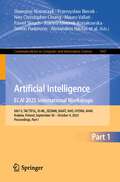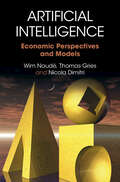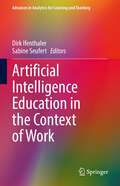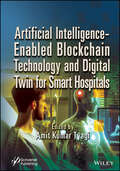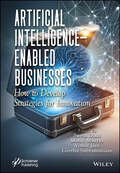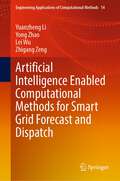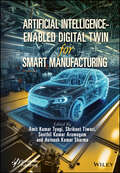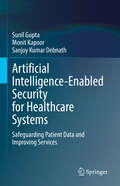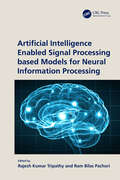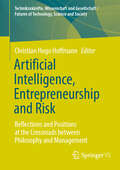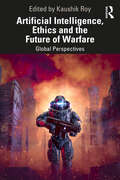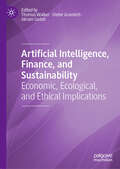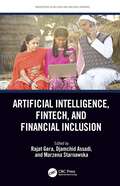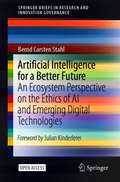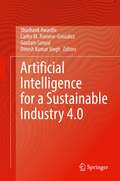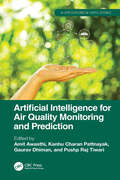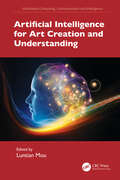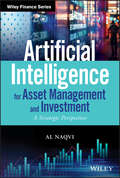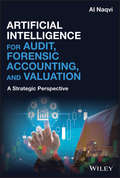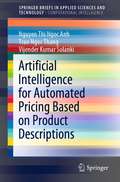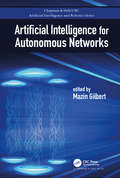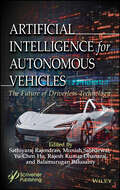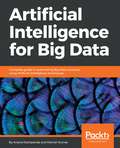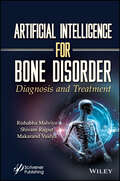- Table View
- List View
Artificial Intelligence. ECAI 2023 International Workshops: XAI^3, TACTIFUL, XI-ML, SEDAMI, RAAIT, AI4S, HYDRA, AI4AI, Kraków, Poland, September 30 – October 4, 2023, Proceedings, Part I (Communications in Computer and Information Science #1947)
by Sławomir Nowaczyk Przemysław Biecek Neo Christopher Chung Mauro Vallati Paweł Skruch Joanna Jaworek-Korjakowska Simon Parkinson Alexandros Nikitas Martin Atzmüller Tomáš Kliegr Ute Schmid Szymon Bobek Nada Lavrac Marieke Peeters Roland Van Dierendonck Saskia Robben Eunika Mercier-Laurent Gülgün Kayakutlu Mieczyslaw Lech Owoc Karl Mason Abdul Wahid Pierangela Bruno Francesco Calimeri Francesco Cauteruccio Giorgio Terracina Diedrich Wolter Jochen L. Leidner Michael Kohlhase Vania DimitrovaThis volume constitutes the refereed proceedings presented at the international workshops of the 26th European Conference on Artificial Intelligence, ECAI 2023, which was held in Kraków, Poland, in September-October 2023. The papers in this volume were presented at the following workshops: XAI^3, TACTIFUL, XI-ML, SEDAMI, RAAIT, AI4S, HYDRA, AI4AI.
Artificial Intelligence: Economic Perspectives and Models
by Wim Naudé Thomas Gries and Nicola DimitriIs Artificial Intelligence a more significant invention than electricity? Will it result in explosive economic growth and unimaginable wealth for all, or will it cause the extinction of all humans? Artificial Intelligence: Economic Perspectives and Models provides a sober analysis of these questions from an economics perspective. It argues that to better understand the impact of AI on economic outcomes, we must fundamentally change the way we think about AI in relation to models of economic growth. It describes the progress that has been made so far and offers two ways in which current modelling can be improved: firstly, to incorporate the nature of AI as providing abilities that complement and/or substitute for labor, and secondly, to consider demand-side constraints. Outlining the decision-theory basis of both AI and economics, this book shows how this, and the incorporation of AI into economic models, can provide useful tools for safe, human-centered AI.
Artificial Intelligence Education in the Context of Work (Advances in Analytics for Learning and Teaching)
by Dirk Ifenthaler Sabine SeufertThis edited volume remedies existing deficiencies in the literature on artificial intelligence and education in the context of work. The topics addressed by this book are: • Supporting formal and informal learning through AI• Human-machine collaboration for learning at the workplace, including the potential of human-AI interaction in professional and vocational education contexts, design, use, and evaluation of human-AI hybrid systems for learning• Intelligent and Interactive Technologies for Learning, including natural language processing and speech technologies; data mining and machine learning; knowledge representation and reasoning; semantic web technologies, chat bot-mediated learning, and conversational learning, • AI-enabled applications for skills management and personalized learning, such as AI-enabled coaching, personalized skill management, and intelligent tutoring systems. • Case studies for the implementation and use of AI-enabled learning and performance solutions, such as personal learning experience platforms, and automated performance feedback.
Artificial Intelligence-Enabled Blockchain Technology and Digital Twin for Smart Hospitals
by Amit Kumar TyagiThe book uniquely explores the fundamentals of blockchain and digital twin and their uses in smart hospitals. Artificial Intelligence-Enabled Blockchain Technology and Digital Twin for Smart Hospitals provides fundamental information on blockchain and digital twin technology as effective solutions in smart hospitals. Digital twin technology enables the creation of real-time virtual replicas of hospital assets and patients, enhancing predictive maintenance, operational efficiency, and patient care. Blockchain technology provides a secure and transparent platform for managing and sharing sensitive data, such as medical records and pharmaceutical supply chains. By combining these technologies, smart hospitals can ensure data security, interoperability, and streamlined operations while providing patient-centered care. The book also explores the impact of collected medical data from real-time systems in smart hospitals, and by making it accessible to all doctors via a smartphone or mobile device for fast decisions. Inevitable challenges such as privacy concerns and integration costs must, of course, be addressed. However, the potential benefits in terms of improved healthcare quality, reduced costs, and global health initiatives makes the integration of these technologies a compelling avenue for the future of healthcare. Some of the topics that readers will find in this book include: Wireless Medical Sensor Networks in Smart Hospitals ● DNA Computing in Cryptography ● Enhancing Diabetic Retinopathy and Glaucoma Diagnosis through Efficient Retinal Vessel Segmentation and Disease Classification ● Machine Learning-Enabled Digital Twins for Diagnostic And Therapeutic Purposes ● Blockchain as the Backbone of a Connected Ecosystem of Smart Hospitals ● Blockchain for Edge Association in Digital Twin Empowered 6G Networks ● Blockchain for Security and Privacy in Smart Healthcare ● Blockchain-Enabled Internet of Things (IoTs) Platforms for IoT-Based Healthcare and Biomedical Sector ● Electronic Health Records in a Blockchain ● PSO-Based Hybrid Cardiovascular Disease Prediction for Using Artificial Flora Algorithm ● AI and Transfer Learning Based Framework for Efficient Classification And Detection Of Lyme Disease ● Framework for Gender Detection Using Facial Countenances ● Smartphone-Based Sensors for Biomedical Applications ● Blockchain for Improving Security and Privacy in the Smart Sensor Network ● Sensors and Digital Twin Application in Healthcare Facilities Management ● Integration of Internet of Medical Things (IoMT) with Blockchain Technology to Improve Security and Privacy ● Machine Learning-Driven Digital Twins for Precise Brain Tumor and Breast Cancer Assessment ● Ethical and Technological Convergence: AI and Blockchain in Halal Healthcare ● Digital Twin Application in Healthcare Facilities Management ● Cloud-based Digital Twinning for Structural Health Monitoring Using Deep Learning. Audience The book will be read by hospital and healthcare providers, administrators, policymakers, scientists and engineers in artificial intelligence, information technology, electronics engineering, and related disciplines.
Artificial Intelligence-Enabled Businesses: How to Develop Strategies for Innovation
by Sweta Dixit Mohit Maurya Vishal Jain Geetha SubramaniamThis book has a multidimensional perspective on AI solutions for business innovation and real-life case studies to achieve competitive advantage and drive growth in the evolving digital landscape. Artificial Intelligence-Enabled Businesses demonstrates how AI is a catalyst for change in business functional areas. Though still in the experimental phase, AI is instrumental in redefining the workforce, predicting consumer behavior, solving real-life marketing dynamics and modifications, recommending products and content, foreseeing demand, analyzing costs, strategizing, managing big data, enabling collaboration of cross-entities, and sparking new ethical, social and regulatory implications for business. Thus, AI can effectively guide the future of financial services, trading, mobile banking, last-mile delivery, logistics, and supply chain with a solution-oriented focus on discrete business problems. Furthermore, it is expected to educate leaders to act in an ever more accurate, complex, and sophisticated business environment with the combination of human and machine intelligence. The book offers effective, efficient, and strategically competent suggestions for handling new challenges and responsibilities and is aimed at leaders who wish to be more innovative. It covers the early stages of AI adoption by organizations across their functional areas and provides insightful guidance for practitioners in the suitable and timely adoption of AI. This book will greatly help to scale up AI by leveraging interdisciplinary collaboration with cross-functional, skill-diverse teams and result in a competitive advantage. Audience This book is for marketing professionals, organizational leaders, and researchers to leverage AI and new technologies across various business functions. It also fits the needs of academics, students, and trainers, providing insights, case studies, and practical strategies for driving growth in the rapidly evolving digital landscape.
Artificial Intelligence Enabled Computational Methods for Smart Grid Forecast and Dispatch (Engineering Applications of Computational Methods #14)
by Yuanzheng Li Yong Zhao Lei Wu Zhigang ZengWith the increasing penetration of renewable energy and distributed energy resources, smart grid is facing great challenges, which could be divided into two categories. On the one hand, the endogenous uncertainties of renewable energy and electricity load lead to great difficulties in smart grid forecast. On the other hand, massive electric devices as well as their complex constraint relationships bring about significant difficulties in smart grid dispatch. Owe to the rapid development of artificial intelligence in recent years, several artificial intelligence enabled computational methods have been successfully applied in the smart grid and achieved good performances. Therefore, this book is concerned with the research on the key issues of artificial intelligence enabled computational methods for smart grid forecast and dispatch, which consist of three main parts. (1) Introduction for smart grid forecast and dispatch, in inclusion of reviewing previous contribution of various research methods as well as their drawbacks to analyze characteristics of smart grid forecast and dispatch.(2) Artificial intelligence enabled computational methods for smart grid forecast problems, which are devoted to present the recent approaches of deep learning and machine learning as well as their successful applications in smart grid forecast.(3) Artificial intelligence enabled computational methods for smart grid dispatch problems, consisting of edge-cutting intelligent decision-making approaches, which help determine the optimal solution of smart grid dispatch. The book is useful for university researchers, engineers, and graduate students in electrical engineering and computer science who wish to learn the core principles, methods, algorithms, and applications of artificial intelligence enabled computational methods.
Artificial Intelligence-Enabled Digital Twin for Smart Manufacturing
by Amit Kumar Tyagi Shrikant Tiwari Senthil Kumar Arumugam Avinash Kumar SharmaAn essential book on the applications of AI and digital twin technology in the smart manufacturing sector. In the rapidly evolving landscape of modern manufacturing, the integration of cutting-edge technologies has become imperative for businesses to remain competitive and adaptive. Among these technologies, Artificial Intelligence (AI) stands out as a transformative force, revolutionizing traditional manufacturing processes and making the way for the era of smart manufacturing. At the heart of this technological revolution lies the concept of the Digital Twin—an innovative approach that bridges the physical and digital realms of manufacturing. By creating a virtual representation of physical assets, processes, and systems, organizations can gain unprecedented insights, optimize operations, and enhance decision-making capabilities. This timely book explores the convergence of AI and Digital Twin technologies to empower smart manufacturing initiatives. Through a comprehensive examination of principles, methodologies, and practical applications, it explains the transformative potential of AI-enabled Digital Twins across various facets of the manufacturing lifecycle. From design and prototyping to production and maintenance, AI-enabled Digital Twins offer multifaceted advantages that redefine traditional paradigms. By leveraging AI algorithms for data analysis, predictive modeling, and autonomous optimization, manufacturers can achieve unparalleled levels of efficiency, quality, and agility. This book explains how AI enhances the capabilities of Digital Twins by creating a powerful tool that can optimize production processes, improve product quality, and streamline operations. Note that the Digital Twin in this context is a virtual representation of a physical manufacturing system, including machines, processes, and products. It continuously collects real-time data from sensors and other sources, allowing it to mirror the physical system’s behavior and performance. What sets this Digital Twin apart is the incorporation of AI algorithms and machine learning techniques that enable it to analyze and predict outcomes, recommend improvements, and autonomously make adjustments to enhance manufacturing efficiency. This book outlines essential elements, like real-time monitoring of machines, predictive analytics of machines and data, optimization of the resources, quality control of the product, resource management, decision support (timely or quickly accurate decisions). Moreover, this book elucidates the symbiotic relationship between AI and Digital Twins, highlighting how AI augments the capabilities of Digital Twins by infusing them with intelligence, adaptability, and autonomy. Hence, this book promises to enhance competitiveness, reduce operational costs, and facilitate innovation in the manufacturing industry. By harnessing AI’s capabilities in conjunction with Digital Twins, manufacturers can achieve a more agile and responsive production environment, ultimately driving the evolution of smart factories and Industry 4.0/5.0. Audience This book has a wide audience in computer science, artificial intelligence, and manufacturing engineering, as well as engineers in a variety of industrial manufacturing industries. It will also appeal to economists and policymakers working on the circular economy, clean tech investors, industrial decision-makers, and environmental professionals.
Artificial Intelligence-Enabled Security for Healthcare Systems: Safeguarding Patient Data and Improving Services
by Sunil Gupta Monit Kapoor Sanjoy Kumar DebnathThe book "AI-Enabled Healthcare Security: Safeguarding Patient Data and Improving Outcomes" focuses on the role of artificial intelligence in enhancing healthcare security and improving patient outcomes. It covers the challenges and risks associated with cybersecurity threats in the healthcare industry and explores the use of AI-based cybersecurity solutions, machine learning algorithms, and predictive analytics to mitigate those risks. The book is intended for healthcare professionals, cybersecurity experts, AI practitioners, and anyone interested in the intersection of healthcare, cybersecurity, and AI. It also highlights emerging technologies and future trends in AI and healthcare security.
Artificial Intelligence Enabled Signal Processing based Models for Neural Information Processing
by Ram Bilas Pachori Rajesh Kumar TripathyThe book provides details regarding the application of various signal processing and artificial intelligence-based methods for electroencephalography data analysis. It will help readers in understanding the use of electroencephalography signals for different neural information processing and cognitive neuroscience applications. The book: Covers topics related to the application of signal processing and machine learning-based techniques for the analysis and classification of electroencephalography signals Presents automated methods for detection of neurological disorders and other applications such as cognitive task recognition, and brain-computer interface Highlights the latest machine learning and deep learning methods for neural signal processing Discusses mathematical details for the signal processing and machine learning algorithms applied for electroencephalography data analysis Showcases the detection of dementia from electroencephalography signals using signal processing and machine learning-based techniques It is primarily written for senior undergraduates, graduate students, and researchers in the fields of electrical engineering, electronics and communications engineering, and biomedical engineering.
Artificial Intelligence, Entrepreneurship and Risk: Reflections and Positions at the Crossroads between Philosophy and Management (Technikzukünfte, Wissenschaft und Gesellschaft / Futures of Technology, Science and Society)
by Christian Hugo HoffmannThis book embarks on a thought-provoking journey that seeks to illuminate the intricate connections between the dynamic realms of AI, Entrepreneurship and Risk Management. This book illuminates the philosophical foundations of AI, examines the fundamental beliefs surrounding AI's nature, and its effects for the human condition. Drawing on the works of eminent philosophers, economists and business leaders alike, the authors of this volume engage in inspirational discussions on ethics, philosophy of technology, and the potential societal ramifications of advancing AI technologies. By grounding the exploration in philosophical reflections, the authors set the stage for a comprehensive understanding of AI's role in entrepreneurship and the inherent risks it entails.
Artificial Intelligence, Ethics and the Future of Warfare: Global Perspectives
by Kaushik RoyThis volume examines how the adoption of AI technologies is likely to impact strategic and operational planning, and the possible future tactical scenarios for conventional, unconventional, cyber, space and nuclear force structures. In addition to developments in the USA, Britain, Russia and China, the volume also explores how different Asian and European countries are actively integrating AI into their military readiness. It studies the effect of AI and related technologies in training regimens and command structures. The book also covers the ethical and legal aspects of AI augmented warfare.The volume will be of great interest to scholars, students and researchers of military and strategic studies, defence studies, artificial intelligence and ethics.
Artificial Intelligence, Finance, and Sustainability: Economic, Ecological, and Ethical Implications
by Thomas Walker Dieter Gramlich Akram SadatiAs the world increasingly recognizes the importance of sustainability, businesses and investors are looking for ways to integrate sustainable practices into their operations and investment decisions. At the same time, advancements in artificial intelligence (AI) and technology are transforming the finance industry and are enabling more data-driven decision-making. The intersection of these fields presents a significant opportunity to accelerate progress towards a more sustainable future, while also improving financial performance. This book explores the crucial role of AI in sustainability and finance, examining how financial technologies and machine learning are shaping the approach of finance professionals towards environmental, social, and governance (ESG) issues. It provides a comprehensive and integrated perspective on how these areas are becoming increasingly intertwined and examines the ethical and social implications of AI in finance and its potential to unlock new opportunities for sustainability. By focusing on the practical implications of these intersections and including both case studies and expert analysis, the book provides valuable insights for practitioners, policymakers, academics, and students alike.
Artificial Intelligence, Fintech, and Financial Inclusion (Innovations in Big Data and Machine Learning)
by Rajat Gera Djamchid Assadi Marzena StarnawskaThis book covers big data, machine learning, and artificial intelligence-related technologies and how these technologies can enable the design, development, and delivery of customer-focused financial services to both corporate and retail customers, as well as how to extend the benefits to the financially excluded sections of society.Artificial Intelligence, Fintech, and Financial Inclusion describes the applications of big data and its tools such as artificial intelligence and machine learning in products and services, marketing, risk management, and business operations. It also discusses the nature, sources, forms, and tools of big data and its potential applications in many industries for competitive advantage. The primary audience for the book includes practitioners, researchers, experts, graduate students, engineers, business leaders, and analysts researching contemporary issues in the area.
Artificial Intelligence for a Better Future: An Ecosystem Perspective on the Ethics of AI and Emerging Digital Technologies (SpringerBriefs in Research and Innovation Governance)
by Bernd Carsten StahlThis open access book proposes a novel approach to Artificial Intelligence (AI) ethics. AI offers many advantages: better and faster medical diagnoses, improved business processes and efficiency, and the automation of boring work. But undesirable and ethically problematic consequences are possible too: biases and discrimination, breaches of privacy and security, and societal distortions such as unemployment, economic exploitation and weakened democratic processes. There is even a prospect, ultimately, of super-intelligent machines replacing humans. The key question, then, is: how can we benefit from AI while addressing its ethical problems?This book presents an innovative answer to the question by presenting a different perspective on AI and its ethical consequences. Instead of looking at individual AI techniques, applications or ethical issues, we can understand AI as a system of ecosystems, consisting of numerous interdependent technologies, applications and stakeholders. Developing this idea, the book explores how AI ecosystems can be shaped to foster human flourishing. Drawing on rich empirical insights and detailed conceptual analysis, it suggests practical measures to ensure that AI is used to make the world a better place.
Artificial Intelligence for a Sustainable Industry 4.0
by Shashank Awasthi Carlos M. Travieso-González Goutam Sanyal Dinesh Kumar SinghThis book outlines the recent advancements in the field of artificial intelligence (AI) and addresses how useful it is in achieving truly sustainable solutions. The book also serves as a useful reference literature in developing sustainable engineering solutions to various social and techno-commercial issues of global significance. This book is organized into two sections: section 1 is focused on fundamentals and principles of AI to lay the groundwork for the second section. Section 2 explores the sustainable engineering solutions development using AI, which addresses challenges in various computing techniques and opportunities in engineering design for sustainable development using IoT/AI and smart cities. Applications include waste minimization, re-manufacturing, reuse and recycling technologies using IoT/AI, Industry 4.0, intelligent and smart grid systems, energy conservation using technology, and robotic process automation (RPA). The book is ideal for the engineers, researchers and students interested in how AI can aid in sustainable development applications.
Artificial Intelligence for Air Quality Monitoring and Prediction (AI Applications in Earth Science)
by Amit Awasthi Kanhu Charan Pattnayak Gaurav Dhiman Pushp Raj TiwariThis book is a comprehensive overview of advancements in artificial intelligence (AI) and how it can be applied in the field of air quality management. It explains the linkage between conventional approaches used in air quality monitoring and AI techniques such as data collection and preprocessing, deep learning, machine vision, natural language processing, and ensemble methods. The integration of climate models and AI enables readers to understand the relationship between air quality and climate change. Different case studies demonstrate the application of various air monitoring and prediction methodologies and their effectiveness in addressing real-world air quality challenges.Features A thorough coverage of air quality monitoring and prediction techniques. In-depth evaluation of cutting-edge AI techniques such as machine learning and deep learning. Diverse global perspectives and approaches in air quality monitoring and prediction. Practical insights and real-world case studies from different monitoring and prediction techniques. Future directions and emerging trends in AI-driven air quality monitoring. This is a great resource for professionals, researchers, and students interested in air quality management and control in the fields of environmental science and engineering, atmospheric science and meteorology, data science, and AI.
Artificial Intelligence for Art Creation and Understanding (Multimedia Computing, Communication and Intelligence)
by Luntian MouAI-Generated Content (AIGC) is a revolutionary engine for digital content generation. In the area of art, AI has achieved remarkable advancements. AI is capable of not only creating paintings or music comparable to human masterpieces, but it also understands and appreciates artwork. For professionals and amateurs, AI is an enabling tool and an opportunity to enjoy a new world of art.This book aims to present the state-of-the-art AI technologies for art creation, understanding, and evaluation. The contents include a survey on cross-modal generation of visual and auditory content, explainable AI and music, AI-enabled robotic theater for Chinese folk art, AI for ancient Chinese music restoration and reproduction, AI for brainwave opera, artistic text style transfer, data-driven automatic choreography, Human-AI collaborative sketching, personalized music recommendation and generation based on emotion and memory (MemoMusic), understanding music and emotion from the brain, music question answering, emotional quality evaluation for generated music, and AI for image aesthetic evaluation.The key features of the book are as follows: AI for Art is a fascinating cross-disciplinary field for the academic community as well as the public. Each chapter is an independent interesting topic, which provides an entry for corresponding readers. It presents SOTA AI technologies for art creation and understanding. The artistry and appreciation of the book is wide-ranging – for example, the combination of AI with traditional Chinese art. This book is dedicated to the international cross-disciplinary AI Art community: professors, students, researchers, and engineers from AI (machine learning, computer vision, multimedia computing, affective computing, robotics, etc.), art (painting, music, dance, fashion, design, etc.), cognitive science, and psychology. General audiences can also benefit from this book.
Artificial Intelligence for Asset Management and Investment: A Strategic Perspective (Wiley Finance)
by Al NaqviMake AI technology the backbone of your organization to compete in the Fintech era The rise of artificial intelligence is nothing short of a technological revolution. AI is poised to completely transform asset management and investment banking, yet its current application within the financial sector is limited and fragmented. Existing AI implementations tend to solve very narrow business issues, rather than serving as a powerful tech framework for next-generation finance. Artificial Intelligence for Asset Management and Investment provides a strategic viewpoint on how AI can be comprehensively integrated within investment finance, leading to evolved performance in compliance, management, customer service, and beyond. No other book on the market takes such a wide-ranging approach to using AI in asset management. With this guide, you’ll be able to build an asset management firm from the ground up—or revolutionize your existing firm—using artificial intelligence as the cornerstone and foundation. This is a must, because AI is quickly growing to be the single competitive factor for financial firms. With better AI comes better results. If you aren’t integrating AI in the strategic DNA of your firm, you’re at risk of being left behind. See how artificial intelligence can form the cornerstone of an integrated, strategic asset management framework Learn how to build AI into your organization to remain competitive in the world of Fintech Go beyond siloed AI implementations to reap even greater benefits Understand and overcome the governance and leadership challenges inherent in AI strategy Until now, it has been prohibitively difficult to map the high-tech world of AI onto complex and ever-changing financial markets. Artificial Intelligence for Asset Management and Investment makes this difficulty a thing of the past, providing you with a professional and accessible framework for setting up and running artificial intelligence in your financial operations.
Artificial Intelligence for Audit, Forensic Accounting, and Valuation: A Strategic Perspective
by Al NaqviStrategically integrate AI into your organization to compete in the tech era The rise of artificial intelligence is nothing short of a technological revolution. AI is poised to completely transform accounting and auditing professions, yet its current application within these areas is limited and fragmented. Existing AI implementations tend to solve very narrow business issues, rather than serving as a powerful tech framework for next-generation accounting. Artificial Intelligence for Audit, Forensic Accounting, and Valuation provides a strategic viewpoint on how AI can be comprehensively integrated within audit management, leading to better automated models, forensic accounting, and beyond. No other book on the market takes such a wide-ranging approach to using AI in audit and accounting. With this guide, you’ll be able to build an innovative, automated accounting strategy, using artificial intelligence as the cornerstone and foundation. This is a must, because AI is quickly growing to be the single competitive factor for audit and accounting firms. With better AI comes better results. If you aren’t integrating AI and automation in the strategic DNA of your business, you’re at risk of being left behind. See how artificial intelligence can form the cornerstone of integrated, automated audit and accounting services Learn how to build AI into your organization to remain competitive in the era of automation Go beyond siloed AI implementations to modernize and deliver results across the organization Understand and overcome the governance and leadership challenges inherent in AI strategy Accounting and auditing firms need a comprehensive framework for intelligent, automation-centric modernization. Artificial Intelligence for Audit, Forensic Accounting, and Valuation delivers just that—a plan to evolve legacy firms by building firmwide AI capabilities.
Artificial Intelligence for Automated Pricing Based on Product Descriptions (SpringerBriefs in Applied Sciences and Technology)
by Nguyen Thi Anh Tran Ngoc Thang Vijender Kumar SolankiThis book highlights artificial intelligence algorithms used in implementation of automated pricing. It presents the process for building automated pricing models from crawl data, preprocessed data to implement models, and their applications. The book also focuses on machine learning and deep learning methods for pricing, including from regression methods to hybrid and ensemble methods. The computational experiments are presented to illustrate the pricing processes and models.
Artificial Intelligence for Autonomous Networks (Chapman & Hall/CRC Artificial Intelligence and Robotics Series)
by Mazin GilbertArtificial Intelligence for Autonomous Networks introduces the autonomous network by juxtaposing two unique technologies and communities: Networking and AI. The book reviews the technologies behind AI and software-defined network/network function virtualization, highlighting the exciting opportunities to integrate those two worlds. Outlining the new frontiers for autonomous networks, this book highlights their impact and benefits to consumers and enterprise customers. It also explores the potential of the autonomous network for transforming network operation, cyber security, enterprise services, 5G and IoT, infrastructure monitoring and traffic optimization, and finally, customer experience and care. With contributions from leading experts, this book will provide an invaluable resource for network engineers, software engineers, artificial intelligence, and machine learning researchers.
Artificial Intelligence for Autonomous Vehicles: The Future of Driverless Technology (Advances in Data Engineering and Machine Learning)
by Sathiyaraj Rajendran Munish Sabharwal Yu-Chen Hu Rajesh Kumar Dhanaraj Balamurugan BalusamyWith the advent of advanced technologies in AI, driverless vehicles have elevated curiosity among various sectors of society. The automotive industry is in a technological boom with autonomous vehicle concepts. Autonomous driving is one of the crucial application areas of Artificial Intelligence (AI). Autonomous vehicles are armed with sensors, radars, and cameras. This made driverless technology possible in many parts of the world. In short, our traditional vehicle driving may swing to driverless technology. Many researchers are trying to come out with novel AI algorithms that are capable of handling driverless technology. The current existing algorithms are not able to support and elevate the concept of autonomous vehicles. This addresses the necessity of novel methods and tools focused to design and develop frameworks for autonomous vehicles. There is a great demand for energy-efficient solutions for managing the data collected with the help of sensors. These operations are exclusively focused on non-traditional programming approaches and depend on machine learning techniques, which are part of AI. There are multiple issues that AI needs to resolve for us to achieve a reliable and safe driverless technology. The purpose of this book is to find effective solutions to make autonomous vehicles a reality, presenting their challenges and endeavors. The major contribution of this book is to provide a bundle of AI solutions for driverless technology that can offer a safe, clean, and more convenient riskless mode of transportation.
Artificial Intelligence for Big Data: Complete guide to automating Big Data solutions using Artificial Intelligence techniques
by Manish Kumar Anand DeshpandeBuild next-generation Artificial Intelligence systems with JavaKey FeaturesImplement AI techniques to build smart applications using Deeplearning4j Perform big data analytics to derive quality insights using Spark MLlibCreate self-learning systems using neural networks, NLP, and reinforcement learningBook DescriptionIn this age of big data, companies have larger amount of consumer data than ever before, far more than what the current technologies can ever hope to keep up with. However, Artificial Intelligence closes the gap by moving past human limitations in order to analyze data.With the help of Artificial Intelligence for big data, you will learn to use Machine Learning algorithms such as k-means, SVM, RBF, and regression to perform advanced data analysis. You will understand the current status of Machine and Deep Learning techniques to work on Genetic and Neuro-Fuzzy algorithms. In addition, you will explore how to develop Artificial Intelligence algorithms to learn from data, why they are necessary, and how they can help solve real-world problems.By the end of this book, you'll have learned how to implement various Artificial Intelligence algorithms for your big data systems and integrate them into your product offerings such as reinforcement learning, natural language processing, image recognition, genetic algorithms, and fuzzy logic systems.What you will learnManage Artificial Intelligence techniques for big data with JavaBuild smart systems to analyze data for enhanced customer experienceLearn to use Artificial Intelligence frameworks for big dataUnderstand complex problems with algorithms and Neuro-Fuzzy systemsDesign stratagems to leverage data using Machine Learning processApply Deep Learning techniques to prepare data for modelingConstruct models that learn from data using open source toolsAnalyze big data problems using scalable Machine Learning algorithmsWho this book is forThis book is for you if you are a data scientist, big data professional, or novice who has basic knowledge of big data and wish to get proficiency in Artificial Intelligence techniques for big data. Some competence in mathematics is an added advantage in the field of elementary linear algebra and calculus.
Artificial Intelligence for Blockchain and Cybersecurity Powered IoT Applications
by Mariya Ouaissa Mariyam Ouaissa Zakaria Boulouard Abhishek KumarThe objective of this book is to showcase recent solutions and discuss the opportunities that AI, blockchain, and even their combinations can present to solve the issue of Internet of Things (IoT) security. It delves into cuttingedge technologies and methodologies, illustrating how these innovations can fortify IoT ecosystems against security threats. The discussion includes a comprehensive analysis of AI techniques such as machine learning and deep learning, which can detect and respond to security breaches in real time. The role of blockchain in ensuring data integrity, transparency, and tamper- proof transactions is also thoroughly examined. Furthermore, this book will present solutions that will help analyze complex patterns in user data and ultimately improve productivity.
Artificial Intelligence for Bone Disorder: Diagnosis and Treatment
by Rishabha Malviya Shivam Rajput Makarand VaidyaARTIFICIAL INTELLIGENCE FOR BONE DISORDER The authors have produced an invaluable resource that connects the fields of AI and bone treatment by providing essential insights into the current state and future of AI in bone condition diagnosis and therapy, as well as a methodical examination of machine learning algorithms, deep learning approaches, and their real-world uses. The book explores the use of artificial intelligence (AI) in the diagnosis and treatment of various bone illnesses. The integration of AI approaches in the fields of orthopedics, radiography, tissue engineering, and other areas related to bone are discussed in detail. It covers tissue engineering methods for bone regeneration and investigates the use of AI tools in this area, emphasizing the value of deep learning and how to use AI in tissue engineering efficiently. The book also covers diagnostic and prognostic uses of AI in orthopedics, such as the diagnosis of disorders involving the hip and knee as well as prognoses for therapies. Chapters also look at MRI, trabecular biomechanical strength, and other methods for diagnosing osteoporosis. Other issues the book examines include several uses of AI in pediatric orthopedics, 3D modeling, digital X-ray radiogrammetry, convolutional neural networks for customized care, and digital tomography. With information on the most recent developments and potential future applications, each chapter of the book advances our understanding of how AI might be used to diagnose and treat bone problems. Audience This book will serve as a guide for orthopedic experts, biomedical engineers, faculty members, research scholars, IT specialists, healthcare workers, and hospital administrators.
